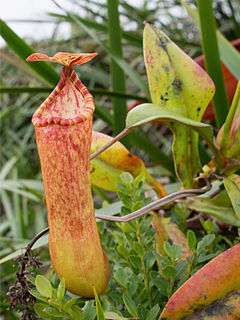Related Research Articles
A genus is a taxonomic rank used in the biological classification of living and fossil organisms, as well as viruses, in biology. In the hierarchy of biological classification, genus comes above species and below family. In binomial nomenclature, the genus name forms the first part of the binomial species name for each species within the genus.

Ugg boots are a unisex style of sheepskin boot originating in Australia and New Zealand. The boots are typically made of twin-faced sheepskin with fleece on the inside, a tanned outer surface and a synthetic sole. The term, ugg boots, originated from Australia, initially for utilitarian footwear worn for warmth, and which were often worn by surfers during the 1960s. In the 1970s, the boots were introduced to the surf culture of the United Kingdom and the United States. Sheepskin boots became a fashion trend in the U.S. in the late 1990s and as a worldwide trend in the mid-2000s. In Australia, they are worn predominantly as slippers and often associated with "daggy" fashion sense and "bogan" culture.
In zoological nomenclature, the specific name is the second part within the scientific name of a species. The first part of the name of a species is the name of the genus or the generic name. The rules and regulations governing the giving of a new species name are explained in the article species description.

TEENick is a defunct teen-oriented television programming block that aired on Nickelodeon. The block launched on March 4, 2001 and lasted until February 1, 2009. TEENick aired on Sunday nights from 6 to 9 p.m. ET/PT and, beginning in 2004, began to also air on Saturday nights from 8 to 10 p.m. ET/PT. Saturday night editions were broadcast as "TEENick Saturday Night" up until 2007 where it then became just "TEENick" for both nights. It was originally hosted by Nick Cannon, and then by Jason Everhart.

Protobothrops mangshanensis, commonly known as the Mangshan pitviper, Mt. Mang pitviper, or Mang Mountain pitviper, is a venomous pitviper species endemic to Hunan and Guangdong provinces in China. No subspecies are currently recognized.
In biological nomenclature, a nomen novum, new replacement name is a technical term. It indicates a scientific name that is created specifically to replace another scientific name, but only when this other name cannot be used for technical, nomenclatural reasons ; it does not apply when a name is changed for taxonomic reasons. It is frequently abbreviated, e.g.nomen nov., nom. nov..

Nepenthes sumagaya is a tropical pitcher plant native to the Philippines. It is known only from Mount Sumagaya in north-central Mindanao, where it grows in open areas at elevations from 1600 m above sea level to the summit at 2247 m. It is sympatric with N. pantaronensis and possible hybrids between these species have been recorded. Owing to its unusual combination of morphological characters, N. sumagaya has no obvious close relatives in the genus.
Paleontology or palaeontology is the study of prehistoric life forms on Earth through the examination of plant and animal fossils. This includes the study of body fossils, tracks (ichnites), burrows, cast-off parts, fossilised feces (coprolites), palynomorphs and chemical residues. Because humans have encountered fossils for millennia, paleontology has a long history both before and after becoming formalized as a science. This article records significant discoveries and events related to paleontology that occurred or were published in the year 2012.
The Nemacheilidae, or stone loaches, are a family of cypriniform fishes that inhabit stream environments, mostly in Eurasia, with one genus, Afronemacheilus found in Africa. The family includes about 630 species.
Saurodektes is an extinct genus of owenettid procolophonoid parareptile known from the earliest Triassic deposits of Eastern Cape Province, South Africa. It was first named by Sean P. Modesto, Ross J. Damiani, Johann Neveling and Adam M. Yates in 2003 and the type species is Saurodectes rogersorum. The generic name Saurodectes was preoccupied by the generic name of Saurodectes vrsanskyi Rasnitsyn & Zherikhin, 2000, a fossil chewing lice known from the Early Cretaceous of Russia. Thus, an alternative generic name, Saurodektes, was proposed by Modesto et al. in 2004. The generic name means "lizard", sauros, and "biter", dektes from Greek. The specific name, rogersorum, honors Richard and Jenny Rogers, owners of the farm Barendskraal, for their hospitality, support and interest in the work of the paleontologists who recovered the holotype. Saurodektes is known solely from the holotype BP/1/6025, a partial skull and some fragmentary partial postcranial elements, housed at the Bernard Price Institute for Palaeontological Research, although the unprepared specimens BP/1/6044, BP/1/6045 and BP/1/6047 might also be referable to it. All specimens were collected on the slopes of the Manhaar Hill at Barendskraal in the Middelburg District, from the Palingkloof Member of the Balfour Formation, Beaufort Group, only 12 metres below the base of the Katberg Formation. This horizon belongs to the Lystrosaurus Assemblage Zone, dating to the early Induan stage of the Early Triassic period.

Muellerina is a genus of parasitic arial shrubs in the family Loranthaceae.
Willi Ziegler was a German paleontologist.
Botanical Latin is a technical language based on New Latin, used for descriptions of botanical taxa. Until 2012, International Code of Botanical Nomenclature mandated Botanical Latin to be used for the descriptions of most new taxa. It is still the only language other than English accepted for descriptions. The names of organisms governed by the Code also have forms based on Latin.

Muellerina eucalyptoides is a hemiparasitic arial shrub in the family Loranthaceae. The species is endemic to Australia. M. eucalyptoides is pendulous in habit, unlike other Muellerina species, but has the long epicortical runners of all Muellerina species.

Muellerina bidwillii, common name Cypress-pine mistletoe, is a hemiparasitic arial shrub in the family Loranthaceae. The species is endemic to New South Wales and Queensland.

Muellerina myrtifolia, common name myrtle-leaved mistletoe, is a hemiparasitic arial shrub in the family Loranthaceae. The species is endemic to New South Wales and Queensland.

Muellerina flexialabastra, common name Hoop pine mistletoe, is a hemiparasitic arial shrub in the family Loranthaceae. The species is endemic to Queensland.

Muellerina celastroides, common names Banksia mistletoe and coast mistletoe, is a hemiparasitic arial shrub in the family Loranthaceae. The species is endemic to New South Wales, Victoria and Queensland.
References
- ↑ I. A. Bardashev; N. P. Bardasheva (2012). Platformennye konodonty iz pogranichnykh zhivet-franskikh otlozhenii (srednii-verkhnii devon). Donish. pp. 1–90.
- ↑ Muellerilepis, a new replacement generic name for Muellerina Bardashev et Bardasheva, 2012 (Conodonta). I. A. Bardashev; N. P. Bardasheva, Paleontological Journal, 2013, volume 47, issue 5, pages 554, doi : 10.1134/S0031030113050055